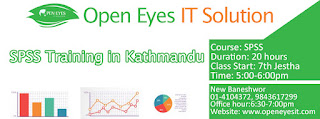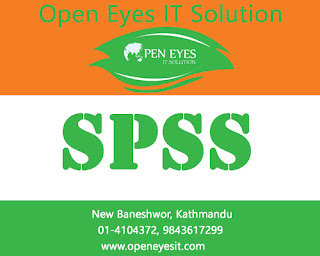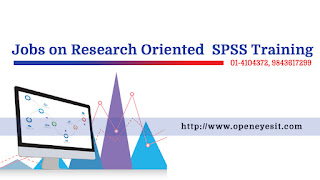 |
| SPSS Training in Kathmandu Nepal |
In this course, you will learn about the principles and practice of data mining using the CRISP-DM methodology. The course structure follows the stages of a typical data-mining project, from collecting data, to data exploration, data transformation, and modeling to effective interpretation of the results. You will learn about modeling as well as the basics of how to read, prepare, and explore data with IBM SPSS Modeler.
1.Introduction to Data Mining
Two applications of data mining
Stages of the CRISP-DM process model
Successful data-mining projects and the reasons why projects fail
Skills needed for data mining
2.Working with IBM SPSS Modeler
MODELER user-interface
Work with nodes
Run a stream or a part of a stream
Open and save a stream
Use the online Help
 |
| SPSS Training in Kathmandu Nepal |
3.Creating a Data-Mining Project
Basic framework of a data-mining project
Build a model
Deploy a model
4.Collecting Initial Data
Concepts "data structure", "unit of analysis", "field storage" and "field measurement level"
Import Microsoft Excel files
Import IBM SPSS Statistics files
Import text files
Import from databases
Export data to various formats
5.Understanding the Data
Audit the data
How to check for invalid values
Take action for invalid values
How to define blanks
 |
| SPSS Training in Kathmandu Nepal |
6.Setting the Unit of Analysis
Set the unit of analysis by removing duplicate records
Set the unit of analysis by aggregating records
Set the unit of analysis by expanding a categorical field into a series of flag fields
 |
| SPSS Training in Kathmandu Nepal |
7.Integrating Data
Integrate data by appending records from multiple datasets
Integrate data by merging fields from multiple datasets
Sample Records
8.Deriving and Reclassifying Fields
Use the Control Language for Expression Manipulation (CLEM)
Derive new fields
Reclassify field values
 |
| SPSS Training in Kathmandu Nepal |
9.Identifying Relationships
Examine the relationship between two categorical fields
Examine the relationship between a categorical field and a continuous field
Examine the relationship between two continuous fields
 |
| SPSS Training in Kathmandu Nepal |
10.Introduction to Modeling
List three modeling objectives
Use a classification model
Use a segmentation model


No comments:
Post a Comment